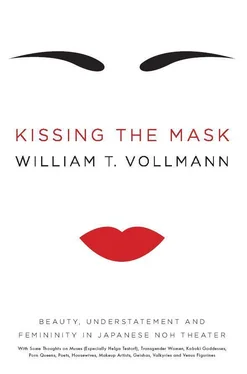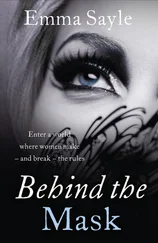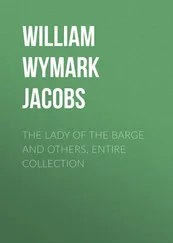2For further discussion, see the “Sadism and Expediency” chapter of my Rising Up and Rising Down.
3It was not, as might have been the case in some Occidental legend, her violent death itself that transformed her into the equivalent of a ghost; it was her unwillingness to die. But most actors are losers in the Noh cosmos and its derivatives. In the fourteenth-century war tale The Taiheiki there are numerous instances of warriors who are too cowardly to cut their bellies open and die for their lords, because they cannot overcome their attachment to this transient world. Of course, we know from Mr. Umewaka’s explication of “Kagekiyo” (above, p. 20) that such warriors will be condemned to hell. ( The Taiheiki itself puts the dilemma in terms only one of which is eternal: “Those of the Heike who cherished honor and died quickly — they became wretched asuras, doomed to suffer for many ages. How regrettable it was! And those who subjected themselves to humiliation by remaining alive — they fell into destitution at once, and were mocked at by all men. How pitiful it was!”)
4When Mr. Umewaka performed this role in a certain Takigi-Noh, he is said to have remained very still on the bridge for a long interval, with his arm folded and his gaze downward. One observer “experienced the beautiful illusion of watching feelings that could no longer be kept pent up inside welling forth as tears.”
1The information sheet assures me that “although some of the present buildings were rebuilt in 1893 after a fire, they kept their original foundations,” and that “the position of the stones” in the garden “were reconstructed by archaeological method about 30 years ago.”
2One especially strident person takes Kawabata to task for Snow Country . She objects to his staying in an expensive room (evidently this confirms his status as an implement of patriarchal objectification), to his creating a character based on a real geisha without telling her (he did change “Komako’s” name), and — here my blood boils — to his “aestheticization” of the geisha’s place in the political-social structure, thereby serving to “block the possibility of criticism.”
3And how could it be otherwise? Kofumi-san, whom you will meet later in the above sentence, told me which hair accessory store she patronized. When I peeped in there, I saw translucent golden combs of pure tortoise shell, which to my ignorant gaze resembled plastic; and there were hairpicks of mother-of-pearl; for some of these one could pay three hundred and forty thousand or even seven hundred thousand yen. And it is proper for geishas to change these ornaments each month! No wonder that their nineteenth-century predecessors sometimes pawned their clothes to keep up. Speaking of clothes, geishas also require new kimonos quite often — every month in the case of a maiko. They can be two million yen each, or occasionally even seven. Obis and wigs, which also must be changed every month, cost as much as kimonos.
4The reason might have been that my method of comparing various representations of femininity causes some people to bristle. Mr. Mikata was not atypical here. When I asked him how Noh and Inoue dance might be similar and different, he replied: “Because that dance originated from Noh, it has an essence of Noh movements, which have been altered and refined. If you superficially compare Noh and Inoue dance, yes, there are similarities. But Noh has more than six hundred years, and Inoue is later. I don’t think that there is any meaning in comparing the two.”
5In Kanazawa, the geisha Masami-san said: “This is very basic. In the tea ceremony, opening a door is quite involved. Our procedure is less formalized. In the tea ceremony there must be a certain number of steps. But we go to rooms of different dimensions, and we must calculate such that we do not step on the seam between two tatami mats. Of course all tatami mats are the same size.”
6Masami-san said that an obi expresses nothing in particular and is “just decoration”; hence a geisha can wear whichever obi she likes. For all I know, the severer requirements of Kyoto may assert otherwise.
7“What would happen if you tried to make a mask with ukiyo-e proportions?” I inquired, and she said: “I think it’s possible, but probably it’s harder to wear. It’s easier if the eyes are lower.”
8The words of this song and of “Black Hair” are translated in the endnotes.
9In her geisha autobiography, a sorrowful woman tells how “I hacked off at the roots the waist-length hair that’d been so dear to me for so many years, and offered it up to who-knows-which-god at a small shrine…”
10The purpose of the red is to increase the perceived depth of the eyes and lightness of the iris.
11The mask carver Nakamura-san thought the fan movements in this geisha dance similar to Noh, “but something about the movement is different.”
1Tadano Makuzu, 1818: “Women exist for the sake of men; men do not exist for the sake of women… Even if she is the more intelligent, how can a woman who thinks that she is lacking something” — i.e.; a penis — “triumph over a man who always thinks of himself as having a surplus?”
1This encounter with a geisha was the only one whose mercantile character, or impersonality, was palpable. I sometimes wonder whether I should feel sorry, or guilty, whether I was in fact intrusive. Having myself occasionally “felt violated” by certain journalists or other outside observers, I strive to behave on such occasions with a resigned professionalism. Perhaps that is how it was for her. I hope that I behaved with respect, and that she was simply in a rush. Indeed, five minutes after she had finished the ochaya-san summoned her urgently to depart for her first appointment of the evening.
2She could remove it by herself. I asked how many kimonos she had, and she said that she had never counted them; since they did not go out of style she sometimes used her grandmother’s.
3Average female hip width is supposedly three centimeters greater than for the male.
4How long did it all take? The other geisha at this ochaya (for there were only two) had danced for me a night or two before. You have met her, her name was Masami-san. She was older than Suzuka, more experienced. She told me that she took ten or fifteen minutes to accomplish all her making-up; but someone still had to help with her kimono. All included, the procedure took an hour and a half. Suzuka might have taken a trifle longer, but perhaps that was the result of my presence and questions.
1It is not my normal practice to include brand names in my books. However, since the makeup procedures of geishas and onnagatas are described in some detail, I thought to achieve a comparable level of specificity. Moreover, since my interpreter rarely deployed makeup herself, it is possible that some unguental functions have been misunderstood in this chapter; if so, the brand names may reveal whichever errors I have made.
2Morris claims that blonde hair indicates the juvenile stage for many Caucasians; hence it is desirable for many women.
1So one customarily hears about this particular manifestation of femininity. For instance, Mishima writes that “an onnagata is the child born of the illicit union between dream and reality.” Furthermore, an onnagata must not strive to act like a woman or he will fail in his effect; he must simply live as a woman when he is not on stage. Mishima says again: The onnagata cannot achieve anything “by a mere slavish imitation of real women.”
2The only vendor of Kabuki makeup in that district, he said, was a certain kimono accessory shop in the Ginza. When I went there to buy what they recommended, a Kabuki actor who happened to be a customer right then gave me the following directions:
Читать дальше












